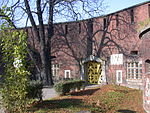Galeria Olympia
Galeria Olympia is an art gallery in Cracow, Poland established in 1999, that shows works by contemporary artists. Its name refers to the name of the founder, Olimpia Maciejewska, and to the title of a 1863 painting by Edouard Manet. The gallery is located at Szlak 13 Street in Kraków. Galeria Olympia was established on 4 June 1999. It was located at Koletek Street until 2001, then it was moved several times. Since 2013 it ran in the Podgórze district, at Limanowskiego Street 24/4b. In 2022 the gallery moved to the new address, Szlak 13 Street. The gallery is run by Fred Gijbels Foundation. Each year it organises various solo exhibitions and at least one group exhibition focusing on a given issue. It held events that were part of Photo Month in Krakow and Conrad Festival (exhibition The Great Forties). Exhibitions previews were a regular contribution to Gadający Pies magazine. Artists shown at the gallery include: Official website
Excerpt from the Wikipedia article Galeria Olympia (License: CC BY-SA 3.0, Authors).Galeria Olympia
Szlak, Krakow Stare Miasto (Old Town)
Geographical coordinates (GPS) Address Nearby Places Show on map
Geographical coordinates (GPS)
| Latitude | Longitude |
|---|---|
| N 50.0706 ° | E 19.9344 ° |
Address
Szlak 13
31-161 Krakow, Stare Miasto (Old Town)
Lesser Poland Voivodeship, Poland
Open on Google Maps









